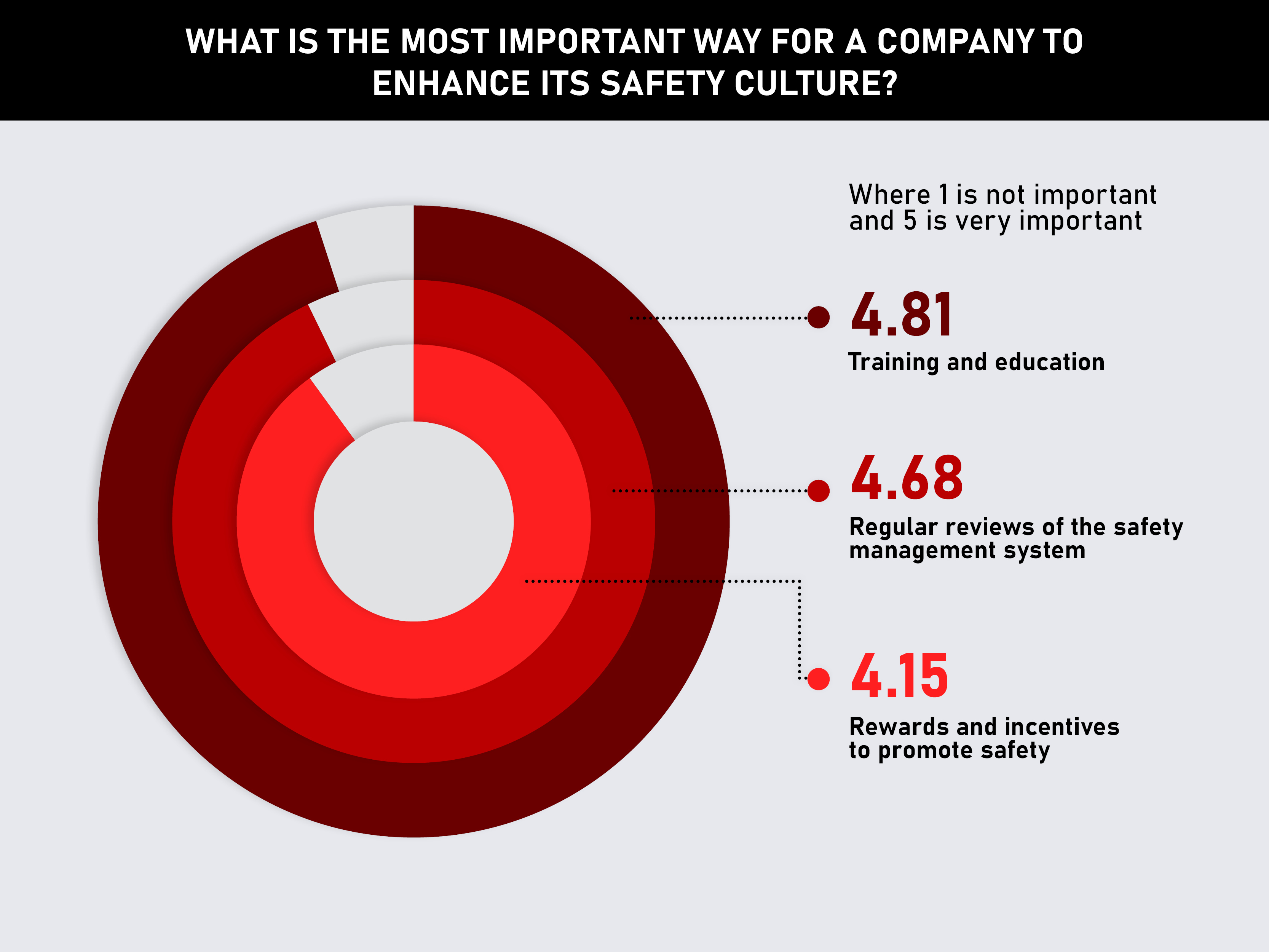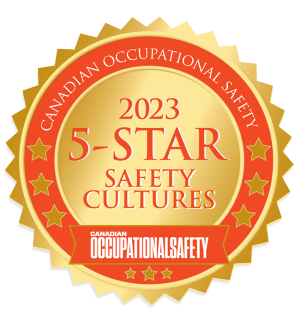What is safety culture? Our 5-star awardees for Best Safety Cultures share how you can foster a culture of safety in the workplace

Employers across Canada are required by law to ensure the health and safety of their workers. This responsibility, however, goes beyond legal compliance. Companies also carry the moral obligation of providing employees with a safe workplace. Having a strong safety culture is key to achieving that.
But what is safety culture exactly?
In this article, Canadian Occupational Safety turns to respected business leaders to provide clarity on the matter. These experts will explain what embodies safety culture in the workplace, how to establish one, and the barriers to implementation.
If your organization is keen on creating a work environment that encourages safety, this can serve as a useful guide. Read on and find out what it takes to build a successful health and safety culture within your business.
What is safety culture?
A strong safety culture is an integral part of any successful workplace. Organizations are responsible for ensuring their employees are protected from all potential hazards, be it physical or psychological. Having a culture of safety in the workplace plays a vital role in preventing accidents and injuries that occur on the job.
Christl Aggus, president and chairperson of the board at the professional association Canadian Society of Safety Engineering (CSSE), provides a humanist perspective.
“A normal or healthy culture would allow lateral movements and empower workers’ autonomy over situations within their control,” she explains. “There are rich traditions and celebrations, respect and tolerance, but most importantly, a feeling of belonging and contributing to something greater.
“There are no profits without workers, and there are no workers without profits.”
Rob Stewart, president and chief science officer at Intactix Systems, adds that vigilance is among the central elements of safety culture in the workplace.
“High-reliability organizations create an environment where problems are detected early and virtually always responded to before a serious incident occurs,” he notes. “And, in that case, this whole safety thing is very, very simple.”
Intactix is a supply chain performance assurance platform and one of the five-star winners of our Best Safety Culture in the Workplace awards.
How can organizations promote safety culture in the workplace?
To find out what organizations view as the most important ways to develop safety culture in the workplace, the COS special reports team surveyed members of participating companies. Here are the results:

Sarah Wilson, president of the Canadian Safety Group (CSG), another five-star awardee for the The Best Work Safety Training in Canada, agrees with the findings.
“I’d start with training and education, then review your SMS, then recognition and rewards,” she says. “The hazards are always evolving. We always have different types of clientele coming in, we’re always going out into different types of environments, and we always have to be up on the newest technology.”
CSG trains businesses in how to operate efficiently while managing their risks. The firm’s network of clients spans a range of industries, including healthcare, manufacturing, and mining.
For Rennie Kissoonsingh, vice-president of operations and safety at fellow five-star winner GDI Integrated Facility Services, having an established safety management system should be the priority.
“You start with your safety management system, then you go into training and communication,” he explains. “Then you reward and incentivize some of the outcomes of that. However, from an importance point of view, training and education are very critical.”
The experts we interviewed also note that there are several other factors that are crucial in building a safe work culture, including:
1. Leadership commitment
According to the experts, one of the most important steps to promoting safety culture in an organization is ensuring that leadership is committed to the cause.
“Safety does absolutely come from the top,” Kissoonsingh says. “We have a CEO who lives and breathes safety. But our bread and butter is labour.
“Our culture is that frontline responsibility, getting everyone accountable for the things they’re doing and making sure they’re knowledgeable with the training and doing risk assessments and all of that to keep things going forward.”
Wilson also emphasizes the importance of leadership commitment in cultivating safety in the workplace but adds that this should be supported by other efforts.
“Communication, mentorship, and leadership are the top things we do to foster a safety culture,” she says.
2. Proper infrastructure
Employers must be able to provide workers with the necessary training and mentorship to perform their jobs safely. These programs, however, must be supported by the right infrastructure to be effective.
“Our goal for 2025 is to have lost-time injuries below 0.1 for the company, which is a very high standard with heavy manufacturing,” says Dale Witty, EHS specialist at BASF Canada. “The next most important thing is infrastructure. And then there’s supporting and investing in people, whether it’s training or leadership training.
“Other places I’ve worked, we’ve had frontline supervisors who never get any actual training; they’re just good at their jobs. So, they move on up, and then they’re thrown to the wolves.”
BASF Canada is a plasticizer producer and among our five-star awardees for Best Safety Cultures.
3. Data-driven insights
Organizations own large amounts of information. They can take advantage of this by using historical data to create models to identify trends and potential hazards.
This is among the strategies that the Technical Standards and Safety Authority (TSSA) is focusing on.
President and CEO Bonnie Rose says that the company is “in the midst of an organizational transformation to become a more modern outcome-based regulator that relies on data to understand risk and drive decision-making.”
TSSA, Ontario’s public safety regulator, has been named a five-star awardee for the second straight year.
“Enhancing our internal safety culture and encouraging a collaborative mindset throughout the organization have been instrumental in driving our transformation forward,” Rose adds. “Being recognized for the second consecutive year validates the efforts we are making to foster a culture of leadership, accountability, and teamwork.”
4. Continuous improvement
Building a strong safety culture requires continuous improvement. This involves regular reviews and assessments of workplace safety programs to identify areas for improvement and compliance with new regulations.
Aggus adds that organizations must show an ongoing commitment to delivering meaningful results.
“I am a firm believer in continuous improvement; therefore, the key for me is less policy and more procedure,” she explains. “Policies are only effective if they are applied, measured, and enforced. Policy and procedures that adequately train and empower workers provide 360-degree benefits.”
Learn more about the different factors that promote a culture of safety in the workplace in this guide.
What challenges do organizations face when establishing a safety culture in the workplace?
Despite already distinguishing themselves as the leaders when it comes to safety culture, our five-star winners continue to focus on challenging areas to further improve. These include:
1. Knowledge transfer
Witty points out that delivering information does not necessarily equate to making the culture of a workplace safer.
“It’s easy to train but it’s more difficult to truly transfer the knowledge,” he explains. “We sometimes fall into the trap of thinking we’re checking our training boxes, but people don’t necessarily have the right level of knowledge on the floor. So, it’s a constant battle.”
2. Burnout
There are many contributing factors to burnout, but regardless of the reasons, it remains among the biggest barriers to improving a workplace’s safety culture.
“We’ve gone from just kind of coasting to the floodgates being open, and demand for everything is huge,” Wilson says.
Wilson says that her organization has introduced education on the signs and symptoms of burnout and implemented a mandatory week off to help workers recharge.
Stewart, meanwhile, says that psychological safety is an area that he feels is important to monitor.
“Psychological safety is important because it impacts reporting,” he explains. “And of course, if we don’t get the bad news that people aren’t reporting, I can’t do anything about it from an organization.
“It certainly impacts the quality of our investigations because their investigators won’t look for the real, true root causes.”
3. Resistance to change
Some employees accustomed to working in a certain way may resist new safety policies and procedures. This is a common issue during corporate mergers or when firms buy other entities.
“When you acquire a company, or when you acquire another contract, you acquire those employees as well,” Kissoonsingh notes. “Those employees are not aligned with your current safety culture. They’ve got a different mechanism. They could be tainted. They’ve got these habits. I think that is the biggest challenge for us.”
4. Compliance issues
Constantly changing laws and regulations pose a huge challenge to many organizations.
Witty provides a real-world example: “About a year and a half ago, BASF corporate-wide, globally, set a standard of four feet for fall protection. Our contractors come in. They come in, and they’re used to working in the construction industry, and 10 feet is their criteria (six feet in industrial). So, there’s some range, but then we’re telling them they have to have a self-retracting lifeline at four feet.”
Witty says that four of BASF’s Canadian factories are fully implemented with peer-to-peer observations to identify and remove barriers to safety. The program has been highly successful and engages participation at all levels. He adds that a fifth site is currently launching the program.

How can you find workplaces that best embody safety culture in Canada?
Our Best in Safety Special Reports Page is the place to go if you’re looking for organizations that foster a strong safety culture in their workplaces. The companies featured in our special reports undergo a rigorous vetting process to ensure that they adopt the highest standards when it comes to employee health and occupational safety.
You can find the complete list of our latest five-star awardees for Best Safety Culture in the Workplace in this comprehensive report.
Are there other organizations in the country that embody a safety culture? Give them a shout out in the comments section below.





